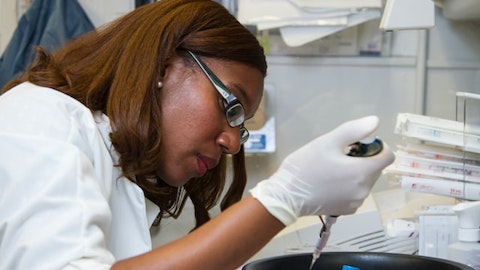Operator: Our next question comes from Michael Yee with Jefferies.
Dina Elmonshed: This is Dina on for Mike. Congrats on all the progress. I just wanted to ask about lung. I know that there was a previous disclosure about potentially seeing some second-line updated lung data, maybe in a medical conference that’s coming up by year-end. Is that still on track? Or what are you guys thinking about the long strategy?
Frederick Vogt: Yes, Dina, we’re looking to put data out along when we think we have meaningful additional numbers available. So we would really like to see more patients, I think, in the study and then we will get that to a medical meeting. I don’t know if we’re going to get it by the end of the year at this point or it could be next year. But it’s important to us to have that data be more significant once we have more patients in the study. Remember, we put out data with 23 patients in a 26.1% ORR with a good signs into our ability. So it could use a dose of additional patients here to help bolster the case. Meanwhile, we’re just executing on the study right now and running hard to make sure we can complete enrollments by ’24.
Operator: Our next question comes from Reni Benjamin with JMP Securities.
Reni Benjamin: Congratulations on all the progress and a very informative call. A couple of quick ones. You mentioned following the strategic portfolio prioritization. I typically think anytime that’s mentioned, there have been programs that have been back-burned. Are there any programs that have been back-burned? Because you mentioned that there are 7 clinical studies that are still ongoing. And as part of that, can you just give us an update as to what’s happening with the ovarian study? Or do you think the endometrial one that you’re going to start will kind of take that one over.
Frederick Vogt: Reni, I think you’re referring to cervical, I think it’s ovarian, right? As we don’t have an ovarian program in our .
Reni Benjamin: Oh sorry, yes, cervical.
Frederick Vogt: Yes. So all those studies continue to run, and we actually think we can continue to run these studies in the budget we’re on. When we say prioritization, we may focus more on enrolling one particular study or putting our efforts on, for example, the LUN-202 study where we need to enroll fast that doesn’t mean we’re closing the cervical study, the endometrial study when it does hit, will hit later and so we don’t foresee a near-term impact on cash. We could always reevaluate the program at that point. What we’re basically saying though is we’re focusing on particular studies that are of high importance like LUN-202 and TILVANCE-301 as well as BLA approvals in the ex U.S. filings at this point so we can drive revenues.
Reni Benjamin: And then just switching gears to the ESMO data that Friedrich mentioned, as of the latest long-term follow-up, can you talk a little bit, I guess, about the PFS for the pooled cohorts of . What kind of — can you just remind us what kind of subsequent therapies these patients got. And if I’m remembering right, correct me if I’m wrong, the 26% of patients that are surviving 4 years, right, their overall survival is [indiscernible] patients are out 4 years. Does that suggest that patients who have been treated with Lifileucel are not in any way detrimentally impacted by any post therapies? Or is there another way to look at that data?
Raj Puri: Reni, I can take this one. So as you know, collecting data, collecting subsequent data is always something that you have to take with a grain of salt. We haven’t put out a comprehensive summary of what we are seeing in the study. But again, I think what you’re seeing in this long-term follow-up data is really the promise that TIL cell therapy has for patients treated with TIL in a setting where there’s really no available care, right? So I don’t actually think there is going to be a pattern here in regards to what these patients would be seeing after. We don’t — certainly don’t see any signals for detriment. What we think is really fascinating in this data is the fact it’s the long-term durability. The fact that we now have patients who have completed the study in a response, meaning a 5-year follow-up, which equals to cure and that we see late deepening of responses and conversions to a complete response, which is speaking to the mechanism of action of a living drug.




